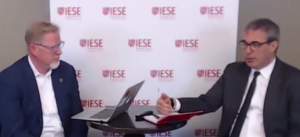
Last week I was in New York and spent some time thinking through the issue of how to react to Covid-19. If you have the time and interest, you can watch the 50 min. Webinar my colleague Kip Meyer and I put together for a collection of Alumni and corporate clients of IESE Business School. The webinar is on Vimeo and you need to follow the link here and then type in the password Welcome. What we are trying to do is to give people practical advice on how best to respond to the situation which, I believe, has the potential to become a full blown economic crisis if people in leadership positions overreact.
On the issue of economic impact, we polled the participants in the webinar and found that 61 % of those who responded felt that Covid-19 had already caused moderate or severe impact on their business. Another 34% had perceived weak signals that the situation may have a negative impact.
Patrick Lagadec is one of the foremost authorities on crisis management. I used his model for the talk last week and will summarize the key ideas we discussed below.
In the first place, Lagadec distinguishes between an accident and a crisis. The main point is that typically people know what to do in the case of an accident but essentially operate without a road map in a crisis. Perhaps the biggest challenge is figuring out what to do without clear and reliable information and also communicating clearly to employees, customers, partners and other stakeholders as the situation unfolds. Lagadec offers five steps in managing a crisis:
Anticipating: While it is too late for anticipating Covid-19, the fact is that epidemiologists and the World Health Organization have been predicting that something like this outbreak would occur for some time. In a crisis, it is advisable to form a crisis management group including people from different parts of the organization and it is desirable that they meet and work with each other prior to the actual crisis, perhaps developing scenarios or running war game simulations. Trust is key in a fast paced, uncertain environment and very difficult to achieve on the go.
Detecting: A major crisis might require management to pay heed to relatively weak or conflicting signals and break with long established paradigms about what kind of information is considered valid. Lagadec points out that information flow actually slows down or even stops in a crisis and that leadership is needed to create a culture which will listen to signals from unconventional sources.
One of the participants in the webinar last week explained how he had a team of data scientists drill into his firm’s supply chain and look all the way down the chain to evaluate the exposure they were facing and to seek out alternatives.
Reacting: When dealing with a crisis, an organization can be shut down by anxiety, the temptation to “wait and see” or fall into denial. Again, strong leadership is required to act, even before everything is clear, but to avoid over reaction and to keep everyone within and even outside of the organization on the same page. Reacting is where many firms are today with respect to the current situation.

For most business leaders, the first thing has been to consider how to keep people safe including employees, customers and civil society as a whole. Each organization needs to figure out for itself what this means. Does it mean providing hand sanitizer, suspending non-essential travel or going even further? Does “safety first” mean sending everyone home? The problem is that if every organization sends everybody home to keep them safe, we will cause an unprecedented social and financial crisis that will be far worse than Covid-19. If you think about business as a positive force in society, then I do not think this option is available . For me, the key issue is how to react in a balanced way which will keep people safe but not add to unwarranted fear and panic.
The evening before the Webinar I went to Madison Square Garden to watch the New York Knicks play the Utah Jazz and was encouraged by the normalcy of the event even though the Knicks lost.
An example of this kind of thinking is to relax a company’s sick leave policy and allow people who do not feel well to stay home with minimal hassle and full pay. In many parts of the world, front line people such as attendants and cashiers make little money and have restrictive or no sick leave. What you do not want to do is have people feel they need to come to work even if they are running a fever and coughing!
Another is to provide such people with additional protection form the public and to hygienically clean spaces with greater frequency like they are doing in New York’s busses and subway cars.
Inventing: The next stage is figure out a way forward which responds to the new situation but allows the organization to continue to fulfill its mission to society and its shareholders. What Lagadec calls “collective creativity” is needed to deal with contradicting demands and to break through deadlock, obstructions, and cynicism. For this to happen it may be necessary to create a “fundamental rupture” with the management systems normally in place and constantly assess what is happening on the ground.
For this reason while the crisis group should have people from different parts of the organization, the heads of the different units may not be the best choice. For a crisis, you need people who are able to see systemic relationships, react to weak signals from unconventional sources of data and be able to think quickly. The team needs to think in terms of contingencies and may need to embrace solutions which are thought to be impossible.
Many organizations are, for example, looking at accelerating their plans for digitalization and looking at doing some of what they do in a virtual environment. Schools are, in particular, looking at doing more virtual sessions and classes. CEIBS in Shanghai has, for example, moved all of its programs on line. The critical issue is to stay true to an organization’s mission and values.
Mobilizing: As specific lines of action emerge, the last step is to get the entire organization on board.
Communications are, of course, key throughout the entire process but need to map onto each stage. There is no point in explaining the way ahead if it is not yet clear what the situation is! Better to first explain that things are serious and ask for information. Then, start to announce measures as they come up and finally begin the process of charting the way ahead.
All of this will require leadership and it is often these kind of situations that really show what kind of leaders people are. Balancing the need to keep people safe with acting responsibly and keeping the business running is not easy but that is the task of a true leader!
There will be another webinar on this topic Monday evening at 18:30 Barcelona time and I understand it will be broadcast live on IESE’s linked page which you can find here.



Our leader doing good but people should do their job too and staying at home. today I saw so many people in street.
In responding to outbreak Covid-19 leaders reacted in various ways. At the company where I work, the company leader makes the decision that all employees work at home to help the government program in deciding covid-19 growth.